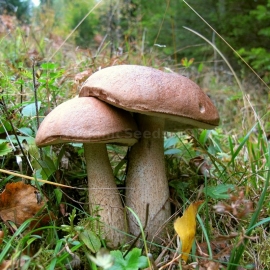 EXCLUSIVE
EXCLUSIVE



Birch Bolete / Lactarius deliciosus - Organic Mushroom's Dry Mycelium
6.10 €
Lactarius deliciosus, commonly known as the saffron milk cap and red pine mushroom, is one of the best known members of the large milk-cap genus Lactarius in the order Russulales.
-
Organic Birch Bolete Mushroom's Dry Mycelium
Lactarius deliciosus, commonly known as the saffron milk cap and red pine mushroom, is one of the best known members of the large milk-cap genus Lactarius in the order Russulales.
It is found in Europe and has been accidentally introduced to other countries under conifers and can be found growing in pine plantations. A fresco in the Roman town of Herculaneum appears to depict Lactarius deliciosus and is one of the earliest pieces of art to illustrate a fungus.
Lactarius deliciosus has a carrot orange cap which is convex to vase shaped, inrolled when young, 4 to 14 cm (1.5 to 5.5 in) across, often with darker orange lines in the form of concentric circles. The cap is sticky and viscid when wet, but is often dry. It has crowded decurrent gills and a squat orange stipe which is often hollow, 3 to 8 cm (1 to 3 in) long and 1 to 2 cm (0.5 to 1 in) thick. This mushroom stains a deep green color when handled. When fresh, the mushroom exudes an orange-red latex or "milk" that does not change color.
In North America, this mushroom is often confused with Lactarius rubrilacteus which stains blue, exudes a red latex, and is also edible.
Lactarius deliciosus is a widely collected mushroom in the Iberian peninsula, specially in the northern part of Catalonia. It is used in Spanish and Catalan cuisine. One recipe recommends they should be lightly washed, fried whole cap down in olive oil with a small amount of garlic and served drenched in raw olive oil and parsley. The same recipe advised that butter should never be used when cooking this mushroom.
Further north and east it is a feature of Provençal cuisine. They are also collected in Poland, where they are traditionally served fried in butter, with cream, or marinated. In Russian cuisine these mushrooms are prepared with pickling and then eaten with sour cream.
In India, the fungus is one of the ten most widely consumed mushrooms by ethnic tribes of Meghalaya. In Cyprus, where they are usually cooked on charcoal and marinated with olive oil and lemon or bitter orange, or fried with onions with red wine.
In some older guides, the saffron milk cap is considered an excellent mushroom, having 'a crisp texture'. In fact, when naming the mushroom, the mycologist had mistaken the mushroom with Lactarius sanguifluus, which is an excellent, pleasantly crunchy mushroom. Today, most mycologists hold Lactarius sanguifluus in higher esteem than its pretender, Lactarius deliciosus.
High consumption of Lactarius deliciosus could cause urine discoloration, namely coloring it orange/red.
